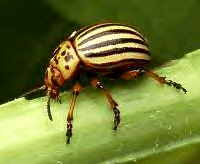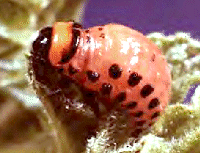
Consulting Entomologist

Tel/Fax: 01275 854224
E-Mail: [email protected]
Site Guide
Site Search
Home Page
Career Page
Insect Files
- Contents
- Bug Index
- The World of Bugs
- Classification of Bugs
- Insect Identification
- Insect Fossils
- Insect Body-parts
- Micro View of Bugs
- Insect Life Cycles
- Insect Defences
- Insects of Nailsea
- Pesticide Safety
- Bibliography
Shortcut to the main groups of insects and other arthropods...
Bug Rhymes & Poems
Links
Shop
Payments (credit/debit card)
Order Coleoptera - Beetles(Coleo-ptera, from Greek koleos = sheath, pteron = wing) |
Class: Insecta Order: Coleoptera | |
| Examples: | ||
|
Minute to large insects whose forewings are modified into hard, leathery wing-cases (called elytra) that meet in a line down the back. The hind wings are membranous, folded beneath the elytra, but are vestigial or absent in many species. Antennae are very variable, but the mouthparts are always of the biting type. Metamorphosis is complex, with four or more larval stages and a pupal stage. Larval types are very diverse, sometimes legless, but nearly always with a well developed head and biting jaws. |
| Different types of beetle larvae: |
Ground Beetles & Rove Beetles |
Longhorn Beetles (Wood-borers) | ||
|
Carrion Beetles (Sexton Beetles) |
Click Beetles (Wireworms) | |||
|
Scarab Beetles (Chafers) |
Weevils & Bark Beetles |
Leaf Beetles & Ladybirds |
Carpet Beetles |
|
|
The beetles, with more than 350,000 known species, rank as the largest Order in the animal kingdom. Over 4,000 species inhabit the British Isles. In the tropical Goliath and Hercules Beetles, with weights in the region of 100 grams, they include the heaviest of all insects. But such is the range of form and size in the Order, that it also contains some of the smallest insects, less than 0.5 mm long. Within the limitations imposed by their biting mouthparts, the beetles have invaded all available habitats - including the sea - and exploited all possible food sources. The Order includes plant-feeders, scavengers, predators and parasites, so that few natural organic materials escape the attention of one or other of these groups. Many species are serious pests: chafers, weevils and many other beetles damage growing crops; several species infest stored grain, flour and other dry food stuffs; carpets and other fabrics are attacked by Carpet Beetles, and timber is weakened and destroyed by Woodworm and other wood-boring beetles. On the other hand, many beetles are useful allies as predators of other insect pests. The aphid-eating Ladybirds are especially important in this respect, while the Dung-beetles and Burying Beetles that consume animal faeces and carrion are important links in the re-cycling of waste matter. |
|
| |
| Colorado Beetle - Leptinotarsa decemlineata | |
|
Description. Conspicuous black and yellow striped adult, 8-12 mm long. Larva is a typical Leaf Beetle type (see above), coloured red, with black spots, and up to 12 mm long. Biology. Lives on wild plants of the nightshade family (Solanaceae), but most frequently found as a pest of cultivated potatoes and tomatoes. Both adults and larvae defoliate plants, often reducing them to a skeleton of bare stems. One or two generation a year, with adults hibernating in the soil. Distribution. Native to North America, but introduced and now widespread over the whole of Europe. Occasionally found in the British Isles, where its presence should be notified immediately to the Ministry of Agriculture, Fisheries and Food (now DEFRA - the Department for Environment, Food and Rural Affairs). LOOK HERE FOR MORE INFORMATION & NOTIFICATION DETAILS (DEFRA) Photo (adult):
Free Stock Photos © <<< TOP |
|
|
| |
| Diving Beetle - Dytiscus marginalis | |
|
Description. Adult 25-35 mm long, greenish-black with yellow margins to the thorax and elytra. Hind-legs flattened and hairy, modified as 'paddles' for swimming. Male with large suction-pads on the front tarsi, for grasping the female during mating. Male elytra smooth and shiny, those of the female usually deeply grooved. Biology. Lives in ponds and other stretches of still-water, rich in pond-weeds. Both adults and larvae come up to the water surface to breath. They are voracious carnivores, feeding on other water animals, including tadpoles and small fish. Adults often fly from one pond to another, particularly at night. Distribution. Common and widely distributed in Europe, including the British Isles, as well as in North America. <<< TOP |
|
|
| |
| Rove Beetle - Platydracus (= Staphylinus) stercorarius | |
|
Description. A typical rove beetle with short elytra, leaving most of the abdomen exposed. Adult 12-14 mm long, black with red elytra and golden patches of hair on the abdomen. Biology. Found in various open habitats where it feeds on other insects, especially on the larvae of flies. Often occurs around dung and carrion. Adults with well developed hindwings (normally folded away beneath the short elytra when not in use) and can fly well. Distribution. Parts of northern and central Europe, including the British Isles, becoming rarer further north. <<< TOP |
|
|
| |
| Stag Beetle - Lucanus cervus | |
|
Description. Adult male quite variable in size, 25-75 mm long, with antler-like mandibles. Female 30-45 mm long, with normal-sized mandibles. Both sexes more or less black with smooth dark brown elytra. The larva is a typical Scarab Beetle type (see above), whitish in colour, with a brown head. Biology. Mainly inhabits oak woodland. The adult beetles can fly and are most active at night. Although the male looks rather frightening with its large antlers, it is quite harmless because it cannot close them with any force. The smaller jaws of the female can give a much stronger nip. The male antlers are used mainly for wrestling with other males. The larvae are wood-borers, living in the root-stocks of rotting, deciduous tree stumps. Their development takes at least five years. Distribution. Central Europe, including southern parts of the British Isles. Becoming increasingly rare in many parts of its range. Photo: V.J. Stanek © <<< TOP |
|
|
(classification of insects) |
(identification key to insect orders) |
| <<< TOP | (use the back button on your web browser to return to the previous page) | TOP >>> |

